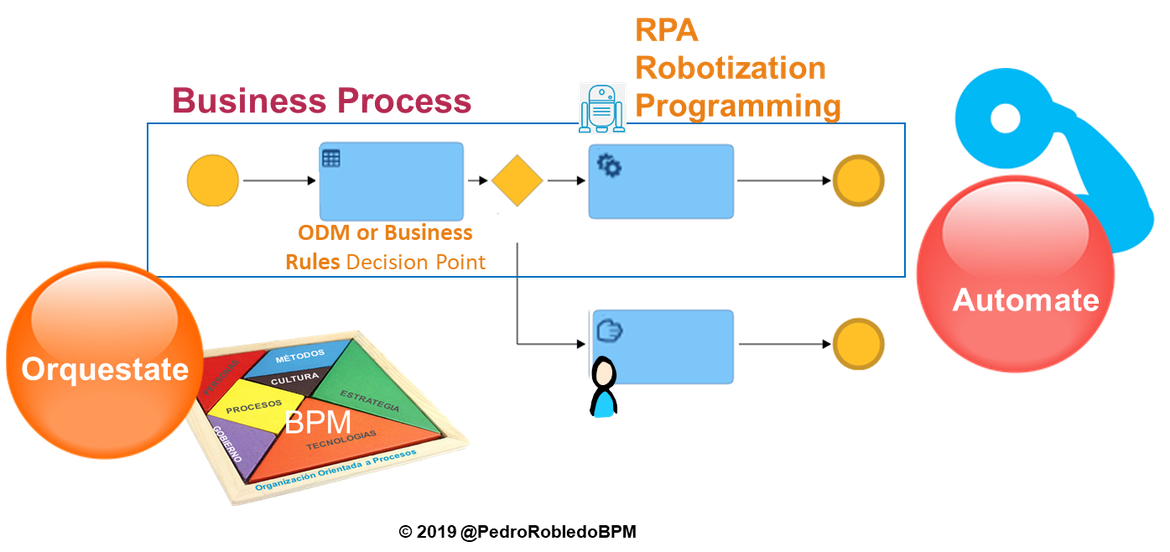¡HI! If you want to propose us a project, send a mail to info@albatian.com


ALL INFORMATION ABOUT
BPM, PROCESS, R & D, TECHNOLOGY
Before automating a process ... improve it!
By: Pedro Robledo, BPM process management expert

Automation has been impacting Enterprises in 2019, and the trends marks than for the next years will be more present in all businesses. The effect of Digital Transformation makes companies think or carry out automation projects. But this is not digital transformation. To be digital transformation, it has to happen that emerging technologies are applied to the business, creating new products and services, new business models and changes in the value chain. In another case, we will be talking about Digitalization, but not about Digital Transformation. But without a doubt, the processes and the quality of the data play a key role both in the digital transformation and in the digitalization of the value chain of an organization.
When companies think of Digitalization they are focusing on the digital automation of their business processes. Robotizing tasks or processes is not Digital Transformation. The great growth of RPA software companies (Robotic Process Automation), together with articles magnifying this software, is causing companies to consider automation projects for their processes. The global RPA services market will reach $ 7.7 billion next year and will grow to $ 12 billion in 2023, according to Forrester.
Institute For Robotic Process Automation defines RPA as “the application of technology that allows employees in a company to configure computer software or a “robot” to capture and interpret existing applications for processing a transaction, manipulating data, triggering responses and communicating with other digital systems”. The reality is that RPA facilitates in processes to automate repetitive tasks PREDICTABLE: Replicating activity on the desktop of the computer; consolidating data in standardized reports or formats; moving data from one database to another; etc. RPA assumes the AS-IS process and creates software bots that mimic human behavior for low-value repetitive tasks. As Forrester says, "RPA takes a tactical approach to isolate and eliminate pain from the process." In the processes from beginning to end, there will be human participation that makes decisions, so RPA will not be the automation solution.
Forrester has also investigated how automation will affect the future of work, predicting a general reduction in the U.S. workforce of 16% by 2030, given that a tenth of new businesses will start their lives with more digital workers than humans. But existing companies need to manage the restructuring of equipment and it is not so simple to carry out a transformation of this type, due in most cases to Unions or Company Committees, or the idea of certain managers not to lose the workforce to office. But companies will not be able to survive by having to compete in a digital ecosystem. The most successful companies in the world today operate with software and employ fewer employees than their predecessors.
Gartner's predictions indicate that automation continues to deliver on the promises of improved cost and higher effectiveness for the clients of infrastructure service providers, and by 2020, more than 50% of current manual operational tasks in infrastructure managed services will be replaced by intelligent automation services. And by 2021, intelligent automation will generate an additional 20% savings over what is achievable today, in application testing services for end users.
Bill Gates says“The first rule of any technology is that automation applied to an efficient operation will magnify the efficiency. The second is that automation applied to an inefficient operation will magnify the inefficiency” (Jeston, 2009)
A process is “a sequence of activities with an order of realization in time, which converts given inputs into an output (result, a product) through methods and support of resources providing value to the organization, which must support the business (or business) strategy, which will allow to analyze operational excellence, facilitating the establishment of performance measures as a tool for continuous improvement ”. When you want to automate, we wonder if we want to cover the entire process or just an activity or a subprocess. And we may be thinking of automating a process by developing an ad-hoc application, running existing applications, orchestrating with existing applications or automating with existing applications.
When we consider the automation of processes, we must take into account the discipline of Business Process Management (BPM), because part of the strategic planning before making any change in a business process. That is, we have to modify a process only when the change is going to impact on the strategic objectives, or by a tactical decision before a critical problem of the process (which surely impacts the strategic objectives in some way). Although any process can be improved, focus must be placed where there is a return on investment. Following the BPM life cycle, once we are clear that we must focus on a process, we must identify it (AS-IS Process) and analyze possible changes in the process that provide the improvement required to meet the challenges pursued. Through tools and methodologies of continuous improvement, we can analyze which less complex changes facilitate greater impact on the business, and therefore, prioritize these changes.
The application of BPM technologies makes it easy to orchestrate an end-to-end process to obtain traceability and ensure the fulfillment of objectives in the execution of the process by all human participants, systems, software bots and machines (IoT). The automation of a process, an activity or a subprocess facilitates productivity by eliminating human intervention.
But where can it be automated in a process and with what technology? You can automate tasks using code scripts, services or RPA robotization. But also, there are decision tasks that can be automated through ODM (Operational Decision Management) or BRMS (Business Rules Management Systems) platforms. Also, we can perform message and document routing through systems integration technologies, such as ESB (Enterprise Service Business), although there is a current trend towards integration through microservices. A BPM engine will be needed when we want to have orchestration of processes from start to finish, making it easier to automate the assignment of tasks to the lists of activities of different participating roles, thus making it easier for workers to invest their time in execution and not in task management.
BPM can take advantage of RPA to automate repetitive activities that do not require human participation and produce significant savings in an Organization. BPM will also take advantage of BRMS to automate business rules that facilitate decision making in workflows. And of integration systems, to connect with systems, data and things.
Companies currently require automation initiatives that incorporate analytical and cognitive capabilities. "Intelligent or cognitive automation" is considered to be the pairing of process automation with more cognitive disciplines of Artificial Intelligence such as machine learning.
Gartner includes automation among the ten main strategic technology trends recently published by 2020. A trend is what Gartner calls "hyper-automation", the combination of multiple machine learning, packaged software and automation tools to deliver work, referring to all the steps of Automation: discover, analyze, design, automate, measure, monitor and reevaluate. Another trend identified by Gartner is "autonomous things," that is, physical devices that use artificial intelligence to automate functions previously performed by humans.
The analyst Connie Moore in her report “State of the Digtial Process Automation Market Trends 2020-2025”, indicates that process automation has been regenerated from its BPM roots, with products prepared for significant changes by 2025, and the technologies of process will be more important than ever, integrating into what will be called the “Intelligent Business Automation” platform.
Technology facilitates any organization to apply automation, and will improve over the years through the evolution of current platforms. But it is necessary to reflect if the process is prepared to automate (or should be improved before) and if such automation is aligned with business objectives.
RELACIONADO
-
How to guide organizations in Maturity in BPM?
by 4 March 16, 2019
-
Why BPM is vital for companies in the energy and utility industry
by Albatian July 13, 2020
-
Does your company have a Digital Culture?
by 4 Dec. 17, 2018
-
Why BPM is Vital for Insurance Companies
by 4 Feb. 22, 2021
-
Process Mining plays an essential role in Digital Transformation
by 4 Sept. 6, 2018
-
Differences between Processes, Procedures and Work Instructions
by 4 Dec. 7, 2017
-
Industry 4.0: the bpm challenge
by 4 July 9, 2017
-
Not enough with an independent Management of a Process
by 4 May 9, 2017
-
Any Business Innovation and Transformation requieres an Enterprise Architecture
by Albatian March 27, 2017
-
Process Digitalization in Digital Transformation
by Albatian Jan. 9, 2017
-
BPM is key to the Digital Transformation
by Albatian Oct. 4, 2016
-
BPM is the most effective discipline of business management
by Albatian Sept. 15, 2016
-
Implementation of quality standards through BPMS
by Albatian May 28, 2012











